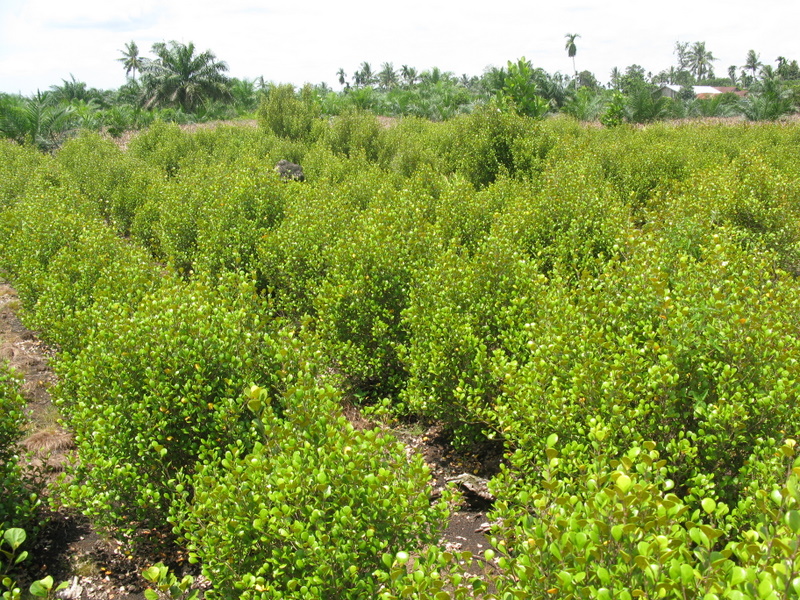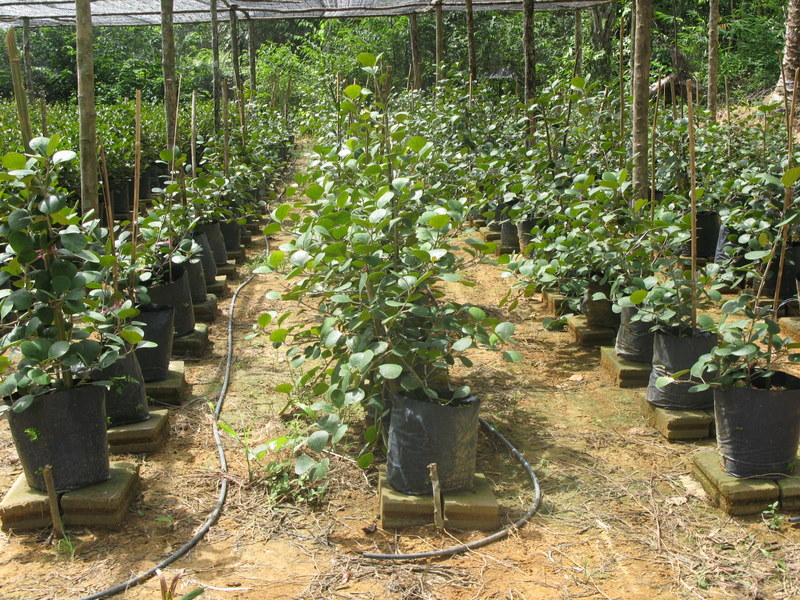Botanical Names
Ficus deltoidea, Ficus diversifolia, Ficus motleyana
Common Names
| Malaysia | Mas cotek, serapat, sempit-sempit, agoluran, ara burung, ara jelatih, ara tanah. |
| English | Mistletoe fig, rustly-leaved bush. |
| Indonesia | Tabat barito. |
Family
Moraceae

Introduction
‘Mas cotek’ is a medicinal plant which is getting popular and widely used by traditional herbalists especially in the east coast of Peninsular Malaysia. The plant is essentially an epiphyte, growing on other larger plants to obtain sunlight. It is found growing abundantly in forests along the east coast of the Peninsular Malaysia or in the upland regions up to 3,000 m above sea level. The herbs, however, do not grow in mangrove swamps/forests.[1]
Morphological Features
The plant can naturally grow up to 2-3 m depending on the accessions and its natural habitat. The leaf shape varies, either round, oblong or oval. The upper leaf surface is green and shiny with golden spots. The lower surface is usually golden in colour with characterised black spot between the veins. More than 40 accessions have been identified and collected. Besides the leaf, the accessions also differ in fruit shape, size and colour, growth habits and resistance to pests and diseases.

Medicinal Properties and Usage
The leaves are usually used in post natal treatments. It is also used to treat gynaecological problems such as the problems of discharge and menstrual cycle. Some women drink ‘mas cotek’ tea as a health tonic to maintain youthful look and vigour. Some traditional healers also believe that the herb can prevent and cure ailments like pneumonia, fever, headache, diabetes, hypertension, heart problems and diarrhoea.[1][2][3][4]
Soil Suitability and Climatic Requirement
The plant requires well drained soil such sandy bris soil for good growth since it cannot withstand waterlogged conditions. The plant can grow well on peat soil. The optimum monthly rainfall is 180–200 cm. ‘Mas cotek’ can also grow in containers such as polybags provided the right medium is used. Excess soil moisture can retard plant growth. [1]
Field Preparation
Land Preparation
The basic requirement for commercial planting of ‘mas cotek’ is an area with a good drainage system. Raised planting beds are necessary for areas that are high in water table and prone to flash floods especially during the wet season. [1]
Production of Planting Materials
‘Mas cotek’ can be propagated either by seeds or cuttings. Using cuttings from young growing shoots is easier, faster and produces better seedlings. Young shoot cuttings are ready for field transplanting after 7-8 weeks in the nursery. The use of shoot cuttings ensures the accessions produced are true to type to that of their mother plants.[1]

Field Planting
The bed size recommended differs according to accessions and the pruning system practised. For optimum growth, the recommended bed size is 1.5 m wide and 0.5 m high. The recommended planting distance is 1.2 m between plants within row and 2.0 m between beds. This will produce a population density of about 4,200 plants per hectare. For sandy soils (containing more than 90% sand) such as bris soil, the use of ameliorating materials like rotted palm oil fruit bunch is essential. These materials increase the moisture content in the planting area, decrease nutrient loss through leaching and thus increase nutrient intake by the plants. Rotted oil palm fruit bunch should be applied at the rate of 5-7 kg/plant by working it into the soil to 30 cm deep from the soil surface.[1]


Field Maintenance
Fertilisation
For sandy soils like bris, two types of fertilisers are recommended: organic fertiliser e.g. chicken manure and inorganic fertilisers with more complete nutrient content. Organic fertiliser should be given as a basal dressing three days before planting and subsequently at six months intervals at the rate of 10 t/ha. The inorganic fertiliser (N:P:K=10:10:10) at the rate of 2 t/ha should also be applied at six months intervals.[1]
Weed Control
Weed is not a major problem if plastic mulch is used. Besides controlling weeds, mulching also ensures the moisture level in the beds is maintained. If necessary, weeds should be controlled by applying contact herbicides or removed manually.[1]
Water Management
Since plastic mulch is used, the recommended irrigation system is drip tape. Every planting row is fitted with drip tape before the plastic mulch is laid on top of the beds. The amount of water supplied to the beds depends on the plant age, soil types and moisture level in the soil.[1]
Pest and Disease Control
‘Mas cotek’ is rather sensitive to nematodes. Infestation by root-knot nematode (Meloidogyne sp.) can cause small galls to form on the roots. This can retard plant growth, expose the plant to other root diseases and even kill the plants. To avoid infestation, the planting medium used in the production of seedling must be free from nematodes.[1]
Harvesting
Traditionally, ’mas cotek’ is harvested from its natural habitat in the forests by pulling the whole plant. A fully grown plant can weigh up to 20 kg. The whole plant which includes roots, fruits and stem is used as raw materials in the production of traditional medicine. Cultivated plants can be harvested by cutting the young growing shoots (about 20 cm long) at four months intervals. Depending on the accession, the potential fresh weight is approximately 13 t/ha. The potential dry yield is about 2-3 t/ha.[1][4][5][6]

Postharvest Handling
The fresh leaves of ’mas cotek’ contain latex which is believed to be toxic. Thus, proper drying is ecessary before consuming or processing into commercial products. Usually, herb collectors sun-dry the plant materials for 4-5 days before selling to the users. At this stage, the moisture content in the plant materials is about 10-15%.[1]
Estimated Cost Of Production
The total production cost for a hectare of ‘mas cotek’ is estimated at RM28,800. The cost of input is estimated to be RM17,000. Other costs include labour and cost of land preparations. The production cost of ‘mas cotek’ is estimated at RM10.00–RM14.00/kg. The production cost was estimated based on the cost of current inputs during writing of this article.[1]
Read More
References
- Musa, Y. 2005. Mas cotek (Ficus deltoidea). In: Penanaman tumbuhan ubatan & beraroma. (Musa, Y., Muhammad Ghawas, M. and Mansor, P., ed.). Pg. 21-27, Serdang: MARDI
- Kamarudin Mat-Salleh and Latiff, A. (editor). 2002. Tumbuhan Ubatan Malaysia. Pg. 184, Kuala Lumput : UKM
- Musa, Y. Azimah, K. and Zaharah, H. 2009. Tumbuhan Ubatan Popular Malaysia. Pg 155, Serdang : MARDI
- Musa, Y. 2006. Evaluation of growth and yield potential of selected emas cotek (Ficus deltoidea) accessions on bris soils. J. Trop. Agric. and Fd. Sc. 34(2):229-235.
- Musa, Y., Yahaya, H. and Wan Zaki, W.M. 2006. Domestication effort of emas cotek (Ficus deltoidea) at MARDI. Paper presented at Nat. Conf. on Agrobiodiversity, Conservation & Sustainable Utilization Kuching, Sarawak, 6-8 Nov. 2006.
- Musa, Y., Yahaya, H., Wan Zaki, W.M. and Zaharah, A. 2005. Emas cotek – A new potential medicinal plant. Buletin Teknol. Tanaman 1: 29-36.


